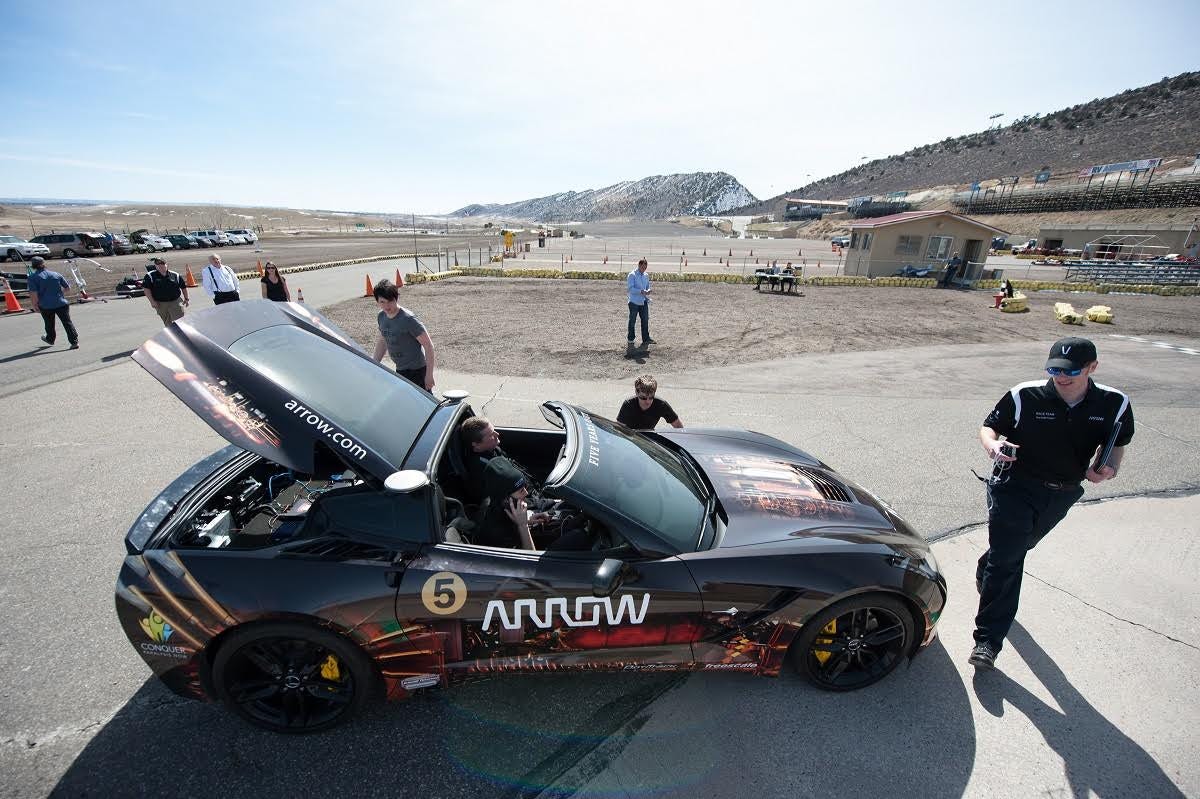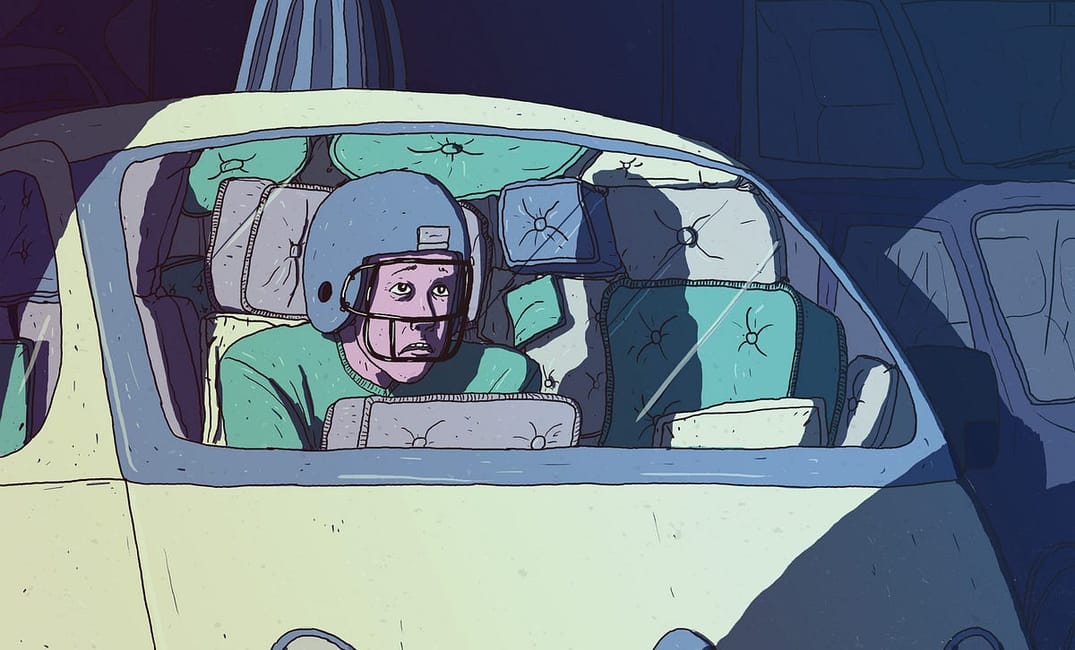
Twenty years from now, I imagine myself parked in my driveway with sweaty palms, sitting behind the controls — or lack of controls — in my first self-driving car. Years ago, I had to learn deep-breathing techniques in order to drive on overpasses. Bridges still haunt me. With no steering wheel, gas pedal or brake pedal, how am I supposed to trust a self-driving car to make all the right decisions?
Dr. Tim Lynch, expert on the Internet of Things (IoT), tells me that my stove and thermostat will communicate in the near future. But trusting one’s household appliances to make appropriate adjustments is a far cry from trusting a vehicle on the freeway to dodge obstacles at 80 miles per hour.
Once, my 16-year-old daughter slammed on the brakes to avoid a flock of turkeys in the road. As we drove on, she asked, “So the rule is, if it’s bigger than a turkey, you stop?”
“Sure.” I laughed.
But what is the rule in a self-driving car?
“Animals can be detected,” said Tetsuya Iijima, head of Nissan’s autonomous vehicle program, when asked about this philosophical question in Drive Magazine in 2015. “But we haven’t set a protocol yet for which animals can be hit and which cannot.”
That’s not comforting.
Dr. Martin Antony, professor of psychology at Ryerson University of Toronto and author of Anti-Anxiety Workbook: Proven Strategies to Overcome Worry, Phobias, Panic and Obsessions, describes two factors that make people feel comfortable that are particularly relevant in a self-driving-car scenario.
One is predictability. Personally, I want to know whether a self-driving car will swerve to avoid turkeys, dogs or even people. The second factor relates to what, according to Antony, may be obvious to most: “People like to be in control.” Many people are afraid of the lack of control that comes with being a passenger. How will they feel when the driver is a computer determining their fate?
Dr. Linda Sapadin, psychologist and author of Master Your Fears: How to Triumph Over Your Worries and Get On with Your Life, echoes this sentiment. With self-driving cars, she anticipates, “For most people, there will be a loss of power, a loss of control and a sense of worry.”
Sapadin’s opinion is backed by research: a study released on March 1, 2016, indicates that 75% of people would be afraid to ride in a self-driving car.
Fear aside, Lynch believes that most people will be “reluctant to give up control and not be able to drive anymore.” “It gets to the heart of the American personality, because we are a nation of cars, and cars have always represented freedom for us,” he explains. “You turn 16, and you get your driver’s license. It’s a big deal.”
Nonetheless, numerous versions of autonomous vehicles are in the works. Google’s vision for self-driving technology would exclude humans from the process altogether, according to Lynch. “Many robotic cars are designed to assist the driver as needed, for example, to avoid an accident or to limit speed, especially if the person is impaired in any way.” Other companies, such as Nissan, are designing cars for humans to take over in a crisis. But Lynch wonders how attentive the person in the driver’s seat will be and whether they will have enough time to react.
Lynch, who earned the first-ever PhD in the psychology of intelligent machines, cautions that “even smart computers and robots will not think like people, because we have an emotional content we apply to situations. We have gut feelings and situational memory that computers can’t access.” He also warns of hacking and privacy issues created by the tons of data that travel between self-driving cars and the companies that make them.
Despite well-recognized fear and resistance to self-driving cars, the car industry continues to struggle to overcome public opposition.
According to Dr. Kentaro Fujita, assistant professor of psychology and principal investigator at the Motivation and Cognitive Science Laboratory at The Ohio State University, people associate driving with a basic need for safety. Fujita suggests that if people believe that self-driving cars can improve their quality of life, consumers may be more likely to choose them. For example, if statistics indicate that self-driving cars are safer, will improve commute times or offer drivers the option to spend time in their cars doing alternative activities, many people will be inclined to make the change.
Quality of life is a primary motivator for innovation at Arrow Electronics, where Joe Verrengia, the global director of corporate social responsibility, led the development of the Arrow SAM Project’s SAM car — a semi-autonomous motorcar built for a specifically trained quadriplegic driver, Sam Schmidt.
Indy car driver Schmidt won at the Las Vegas track in 1999 before crashing during a practice lap in Orlando in 2000 and losing mobility from his collarbone down.
The SAM car’s infrared cameras respond to Schmidt’s head movements; the acceleration and braking react to a single mouth device; and a military-grade GPS tracks the car within five inches — like a guardrail.

Verrengia says the GPS can be frustrating for Schmidt, because it doesn’t let him take the fastest path. “To take the ‘racer’s line,’” Verrengia explains, “Schmidt needs to be up high as he approaches the turn, and then come down low as he comes out of the turn.” On occasion, the team turns off the GPS to allow Schmidt to go faster than the system would allow.
Schmidt has a balanced perspective on the car’s limitations. “Arrow had a very methodical plan. I was the risk taker of the bunch, pushing the envelope on the technology. Every relationship needs a gas pedal and brake pedal. I was the gas.” Schmidt’s objective assessment serves as an unintentional metaphor for the progress of the entire self-driving-car industry, as public concerns push back against the technology.
For instance, Peter Mandel, an IBM software products manager in Silicon Valley, enjoys how his Tesla responds if he needs to pass someone and has no interest in handing over control to a car.
Yet, Mandel says, “Self-driving cars will have better safety features. When all cars are self-driving, there will be a value to society.” Like Google, he believes we need to “get all humans out of the picture.”
He adds, “Early on, I would be quite paranoid to surrendering control. That will go away as software matures.” Eventually, Mandel explains, “You can use that time to do something useful. That’s the value.”
Peter Vinsel, an engineer at another Silicon Valley company, NetScout, also sees the potential benefit in allowing people to free up their commuting time. Vinsel has raced at the semi-professional level, and a few years ago, he enjoyed test-drives in self-driving cars on the track. He was able to relax, despite his tendency toward feeling tension in the passenger’s seat.
In theory, Vinsel supports the idea of developing self-driving cars. “I actually really like the idea for society, because driving is one of the most dangerous things we do every day. Far more people die every day in car accidents than in mass shootings,” Vinsel reflects. “Self-driving cars will make transportation more efficient and safe.”
Still, antilock brakes are the most advanced technology Vinsel will accept in his own vehicle. Reflecting on the future of self-driving cars, he says, “Personally, I just can’t help praying it’s not in my lifetime.”







